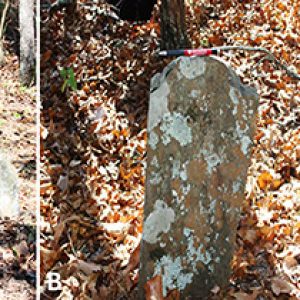calsfoundation@cals.org
Cedar Grove Cemetery (Johnson County)
aka: Mason Cemetery
aka: Darnell Cemetery
The Cedar Grove Cemetery near Clarksville (Johnson County), not to be confused with cemeteries of the same name in Boone and Scott counties, was used by the initial settlers of the area and is located between the Interior Highlands of the Boston Mountains and the Arkansas River Valley of Arkansas. The cemetery is currently covered with overgrowth of vegetation. The graves have recessed, and many of the headstones have been toppled. Also, there are small trees and shrubs growing throughout the area both near and over marked gravesites.
According to tradition, early white settlers founded the cemetery. Unevenly cut headstones carved from local sandstone were used as grave markers, although some no longer have readable markings. It is unknown what kind of markings, if any, they once had. Dates on some of the gravestones indicate that the cemetery was already present when the land was initially deeded from the government in 1883 to the first landowner, Jesse Mason. Furthermore, there is some hint that the land was used prior to Mason’s ownership, as the land survey of 1831 indicates some square farming fields.
A few miles south of the cemetery is a small watershed that flows toward the former site of Spadra, a large trading post on the Arkansas River, in use several decades before the Louisiana Purchase. There is also some contradictory data as to who first homesteaded the property.
Data from a scientific study on the age of lichens (a composite organism that arises from algae or cyanobacteria) that grew on the gravestones clearly revealed that the graves were established well before the first homesteaders were recorded. Also, information from the Johnson County Historical Society verified dates on some of the gravestones.
Trees at the cemetery have been reported to range in age from seventy-one to 118 years. The ages of trees located near or over twenty-three individual gravesites indicated that the cemetery was abandoned around 1922, the time of the last marked gravestone. The oldest gravestone was established in 1800, although not every gravesite possessed a marked gravestone. The cemetery was surrounded by a fence at one time but it later deteriorated. The property was reportedly used for grazing cattle until the late 1970s.
The earliest known burial at this cemetery was forefather of the Joshua Dillon (1785‒1860) family. Other family members reportedly buried there are: his wife, Nancy (Stack) Dillon (1801‒1858); their son, Joshua H. Dillon (1832‒1919); and his wife, Susan (Ray) Dillon (1842‒1906).
For additional information:
Cedar Grove Cemetery. Find a Grave. https://www.findagrave.com/cemetery/2189912/cedar-grove-cemetery (accessed February 25, 2021).
Cedar Grove Cemetery Physical Records. Johnson County Historical Society Archives, Clarksville, Arkansas.
Kluthe, Brandy Garrett, Margaret Guiccioni, and Steven L. Stephenson. “Using Lichenometry, Dendrochronology, and Historical Data to Establish the Relative Age of an Abandoned Cemetery in Northern Arkansas.” Ethnobiology Letters 9 (2018): 253–262.
Myster, R. W. “A Comparison of Tree Replacement Models in Old Fields at Hutcheson Memorial Forest.” Journal of the Torrey Botanical Society 137 (2010): DOI:10.3159/09-RA-012.1.
Chris T. McAllister
Eastern Oklahoma State College


 Cedar Grove Cemetery
Cedar Grove Cemetery 



Comments
No comments on this entry yet.